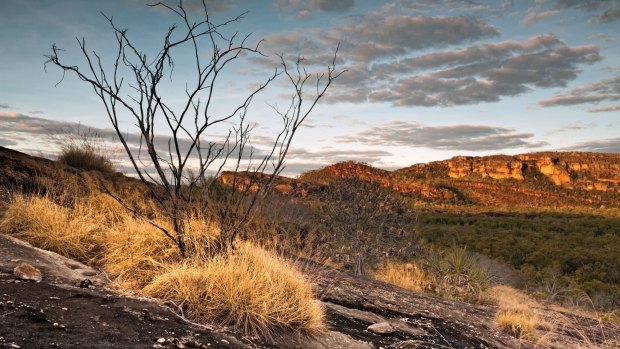This was published 3 years ago
Kakadu National Park travel guide: Where Mother Nature lets her hair down

Dusk falls over the Kakadu National Park, NT.Credit: Getty Images
Saltwater crocodiles are deceptive creatures. The one I'm admiring is lying on a muddy bank like a statue, completely immobile, not even blinking, but it takes a nanosecond to become a Scud missile, launching itself into the muddy water and emerging with a barramundi thrashing in its jaws. All just a few metres from the bow of our cruise boat on Kakadu's Yellow Water Billabong.
A two-hour drive east of Darwin, Kakadu National Park is Mother Nature with her hair down, home to a huge variety of wildlife, from the elegant and colourful Leichhardt's grasshopper to the imperious white-bellied sea eagle. Richly endowed with Indigenous cultural sites, palm-fringed lagoons, waterfalls and wetlands, Kakadu was one of the first regions in Australia to be included on UNESCO's World Heritage List.
Despite its enormous size – some 20,000 square kilometres – Kakadu's wildlife and cultural treasures are concentrated in a few small areas.
One of the most spectacular of these is Yellow Water Billabong, a branch of the South Alligator River that becomes an open-air zoo as it recedes during the April to October dry season, packed with frogs, birds, snakes and saltwater crocodiles, the park's main wildlife drawcard.
The bird life of Kakadu is phenomenal. Expect stately brolgas, jabiru storks, black cockatoos, egrets, honeyeaters, whistling ducks and magpie geese that erupt from the soggy grasslands of the floodplain. Jacanas, known as Jesus birds for their apparent ability to walk on water, perform stiff-legged dances across lily pads.
This natural abundance provided the Gaagudju people of Kakadu with a rich source of food, while the sandstone caves and rock overhangs of the Arnhem Land escarpment gave them shelter.
Where they camped they daubed the walls with charcoal, clay and ochre, creating galleries of some of mankind's oldest art and the longest unbroken chain of artistic expression to be found anywhere on our planet.
This rock art provides evidence of a changing planet in its depiction of animals that are no longer found in this region, including the thylacine, long since hunted to extinction. Likewise, the big red kangaroos have disappeared since the open plains that existed here gave way to woodland.
Besides depicting fish and animals, spirit figures and rainbow serpents, the Indigenous artworks also show the evolution of an artistic style, moving from simple stick figures to complex mythological paintings that indicate a rich culture full of legends and dreamings.
Another of Kakadu's headliners is to be found in the creeks and waterfalls along the cliffs that separate Kakadu from Arnhem Land.
At several places, waterfalls tumble into deep swimming holes, the perfect antidote to Kakadu's heat and dust. Two of the most popular are Twin Falls and Jim Jim Falls, where the water spills more than 200 metres in a sheer drop.
Better still is Barramundi Gorge, known as Maguk to the Gaagudju people, where the water cascades into an emerald-green rock pool fringed by pandanus palms. It's spectacular, and well worth the two-kilometre hike to get there.
The accepted wisdom has it that the best time to visit Kakadu is during the dry season, when the steam-room humidity and high temperatures have subsided. This is all true, and the majority of the park's visitors follow this advice, but the wet season has its own charm. According to the Gaagudju calendar, this is the time of Namarrgon, the Lightning Man, who pounds the earth with high-voltage spears and drenches the land with sheets of rain.
While the wildlife is more widely dispersed and access to some areas of the park becomes impossible, wet-season Kakadu has a newborn gloss.
What to watch
Crocodile Dundee, filmed largely in Kakadu, turned Paul Hogan from an Aussie icon into an international star when it was released back in 1986, and it still has its moments. Break out the Tim Tams and watch it on iTunes or Google Play – that New York City knife scene remains solid gold.
This article appears in Sunday Life magazine within the Sun-Herald and the Sunday Age on sale June 7.
Sign up for the Traveller Deals newsletter
Get exclusive travel deals delivered straight to your inbox. Sign up now.